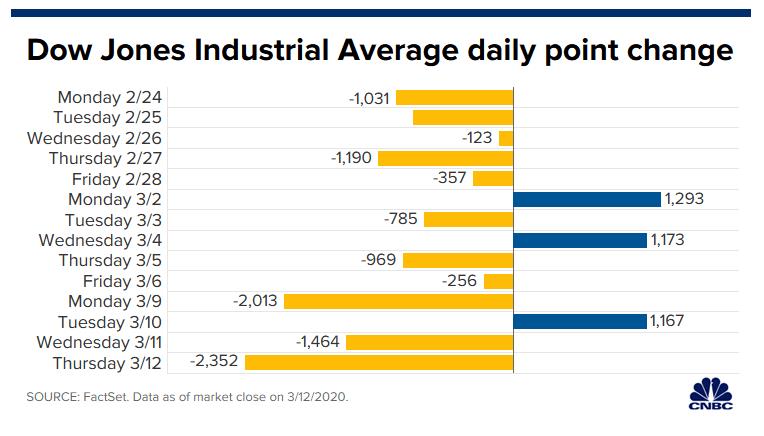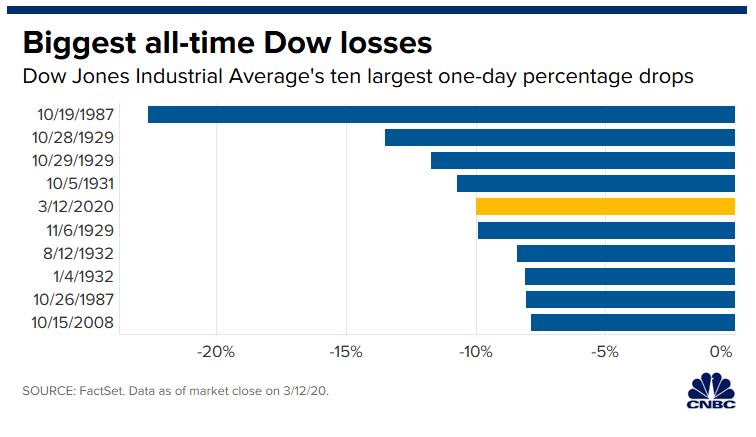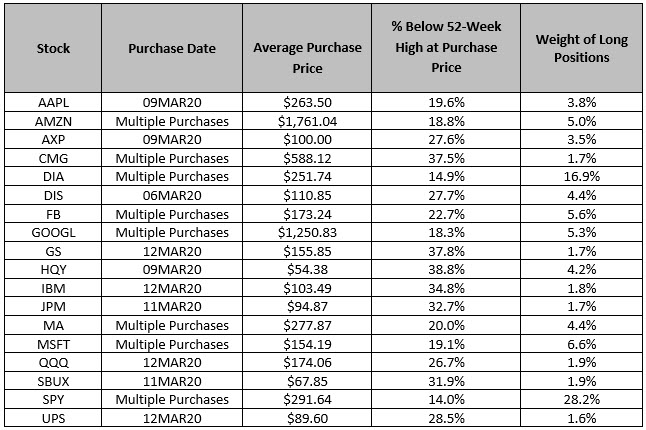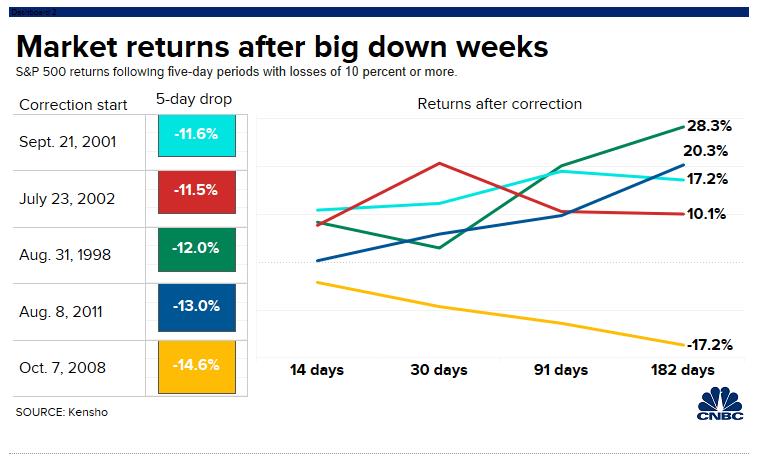The coronavirus (COVID-19) epidemic has pummeled stocks and has caused a complete collapse of the entire market. Broader indices such as the S&P 500, Nasdaq, and Dow Jones have lost over 20% of their value, while most individual stocks have lost 20%-70% of their market capitalization. Airlines, cruise lines, and casinos have been hit particularly hard. Other stocks have been hit due to the market-wide meltdown, and many opportunities have been presented as a result. I'd be remiss if I didn't use this unique opportunity to start buying stocks and take long positions in high-quality companies. Throughout this market sell-off, I have begun to take long positions in individual stocks, particularly in the technology sector and broad market ETFs that mirror the S&P 500, Nasdaq, and Dow Jones.
The Financial Crisis and 1987 Black Monday Comparators
The broader market sold off in a historic downward move as the coronavirus has spread outside of China throughout the rest of the world, effectively shutting down economic activity on a grand scale. During the last week of February, the Dow Jones and S&P 500 sank by 12% and 11% for the week, respectively. This marked the worst weekly performance since the financial crisis for the markets. The Dow posted its biggest one-day loss ever during the week and tumbled into correction territory, down more than 10% along with the S&P 500 and Nasdaq.
As the markets moved into March, the S&P 500 officially closed in a bear market on March 12th, down more than 26% from its record high set just last month. This ended the historic 11-year bull market run. The Cboe Volatility Index (VIX) jumped to more than 76 and hit its highest level since 2008 (Figure 1). On March 12th, The Dow Jones and S&P 500 had its worst drop since the 1987 "Black Monday" market crash, when it collapsed by more than 22% (Figure 2).
This market-wide meltdown is in response to the negative impact that COVID-19 will likely have on the global economy and corporate earnings. A wide array of companies have already issued warnings about their upcoming quarterly earnings. This placed a damper on the outlook for the markets, especially with rising concerns over a potential outbreak occurring in the United States. The OPEC fiasco and plummeting oil prices are exacerbating this market weakness. These events are presenting opportunities to buy stocks across the board with high-quality names and the broader indices on the whole.

Figure 1 – Extreme market volatility over a three week period leading to the sharp market declines accompanied with a 25% market correction

Figure 2 – 1987 market sell-off comparator and the recent market sell-off of 10% in a single day on 03/12/2020
Initiating Long Positions
After the epic rebound of 10% for the broader indices on March 13th, the S&P 500, Dow Jones, and Nasdaq were still off 20%, 21.5%, and 19.8%, respectively, from their highs. Throughout this stretch of market weakness, I started to buy long positions in names that present compelling value and growth beyond the COVID-19 health crisis. These names are well-positioned to explode higher when the market inevitably rebounds. Many of these positions have been purchased well off their highs, and I've averaged down throughout this sell-off. Some positions were initiated too early in hindsight; however, I've scaled into these names over time with multiple purchases in small increments (Table 1).

Table 1 – Initiating long positions in small increments throughout the market sell-off to lock-in double-digit discounts from 52-week highs
Market Sell-Off Perspective
Before COVID-19 induced correction, since World War II, the S&P 500 has had 26 market corrections. During these corrections, the S&P 500 has declined on average of 13.7% and has taken approximately three to four months to recover. The S&P 500, after dropping 12% to end February, was the fastest such correction on record. From the end of February into mid-March was the most volatile action since the 2011 panic over a feared U.S. debt default and 2008 financial crisis.
Getting started is easy! Test our scanning tools and signals with a 30-day trial.
Analysis of prior market declines of 10% or more over five trading days since 1990 shows that equities tend to rebound in a matter of weeks. Excluding the October 2008 plunge of 14.6%, every such sell-off has led to positive returns just two weeks after the fall. For example, in the wake of the 9/11 attacks, the S&P 500 then gained 10.9% over two weeks after selling off. Those gains ballooned to 12.3% one month after the sell-off and 19% after three months (Figure 3).

Figure 3 – Market rebound after 5-day drops of 10 percent of more
Barring the sell-offs associated with the great financial crisis, "S&P 500 performance was positive over 90% over the time, in both 1-day and 5-day scenarios," he added. "And to be clear, as bad as Dec '18 felt, Feb was nearly as bad ... and we got there much more quickly."
Looking at data going back to 1930, Bank of America found that if an investor missed the S&P 500′s 10 best days in each decade, total returns would be just 91%, significantly below the 14,962% return for investors who held steady through the downturns.
Conclusion
After this epic sell-off, I'd be remiss if I ignored buying stocks at these correction levels and didn't start buying into this weakness. There are a plethora of high-quality names that are selling at deep discounts. Some are off ~40% from their 52-week highs. When you sell during a panic, you may miss the market's best days as rapid sell-offs often lead to quick bounces. COVID-19 has sent shock waves through the markets, causing double-digit declines across all major indices. Selling here has proven to put investors at risk for missing out on some of the best days ahead for the market. COVID-19 coupled with the oil market sell-off could be an excellent opportunity to take long positions on high-quality names such as Apple (AAPL), Amazon (AMZN), Chipotle (CMG), Disney (DIS), Microsoft (MSFT), Google (GOOGL), Facebook (F.B.), Mastercard (M.A.) and Starbucks (SBUX) to name a few as well as the broader indices such as SPY (S&P 500 ETF) and DIA (Dow Jones ETF). Selling far out cash covered puts and put spreads on high-quality stocks that have corrected ~20%-plus may be a great strategy to mitigate further downside and define your risk.
Thanks for reading,
The INO.com Team
Disclosure: The author holds shares in AAPL, AMZN, DIA, GOOGL, JPM, MSFT, QQQ, SPY and USO. The author has no business relationship with any companies mentioned in this article. This article is not intended to be a recommendation to buy or sell any stock or ETF mentioned.

In all do respect, I truly think your living in fantasy land, and this goes against everything I learned here
Another bozo calling bottom. We'll hang onto this undoubtedly self-serving suggestion. Is this financial advice? Shouldn't I consult a qualified advisor first? No, not at all. That would be remiss of me.
Stuff it.
Cash is king right now, as they say. Good idea to start buying at these levels if you can, even though I think there is more downside ahead.